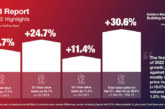 Chris Piper, Sales Director for Housing Developers at Ibstock Concrete, looks back at the last 12 months to discuss some of the biggest challenges faced by property developers and the key learnings that can be implemented throughout 2022.
Chris Piper, Sales Director for Housing Developers at Ibstock Concrete, looks back at the last 12 months to discuss some of the biggest challenges faced by property developers and the key learnings that can be implemented throughout 2022.
I’m sure I speak for the entire industry when I say 2021 has been extremely difficult for construction, particularly for housebuilders and developers. Every corner of the sector has been significantly impacted by the repercussions of the COVID-19 pandemic and Brexit, with materials shortages, distribution delays and a significant uplift in demand creating a perfect storm, not just throughout the UK, but across the world.
Over the last 12 months, the UK government has continued to position the construction industry at the epicentre of driving the nation’s economic recovery and growth, with the development of residential projects central to achieving this.
The Stamp Duty holiday, in addition to the Affordable Homes Programme, which will support the construction of 180,000 new homes, created a housing market boom that significantly increased demand for building materials, with a wide category of materials, including roofing and fencing, significantly affected.
All manufacturers experienced low inventory levels at the beginning of 2021 due to dispatching throughout 2020 lockdowns whilst manufacturing output was suspended. This meant that the continued rise in demand, which was further impacted by the uptake in renovation projects, placed them in an extremely difficult position. This was further complicated by implications of the Brexit trade deal, with major haulage shortages created due to the reduced availability of European drivers.
High profile infrastructure projects, including the progression of HS2, also impacted the availability of necessary building materials, such as concrete, as the government continued to push forward with major national construction developments to help power the UK’s economic growth throughout 2022.
All of these factors created an extremely challenging market, one that we are still operating within and will continue to throughout next year.
As a business at the heart of building, we understand the importance of assured supply and acknowledge that, due to a number of factors, this is a major issue that is affecting both ourselves and the wider market. Supporting our comprehensive network of customers in meeting their commitments is our number one priority, and until all of our customers are receiving the levels of materials they need to meet their business requirements, we will not stop pushing and innovating to identify how we can successfully fulfil demand.
This includes continuing to make strategically-led decisions to support the manufacture of building products that are experiencing the highest demand, including the application of strategic shift pattern changes within our factories. This optimises every single hour to increase manufacturing output, whilst operating in a COVID-secure way to continue to protect the health and well-being of our employees, suppliers and customers.
We have also continued to undertake significant investment throughout the business, with increased manufacturing capabilities, range rationalisation and enhanced product quality protocols being implemented to help increase capacity, without compromising on product quality.
Communication and trust lies at the core of overcoming this turbulent trading environment, and we are committed to having open and consistent dialogue with our customers to establish as much forward visibility as possible of orders and identify how we can continue to implement key learnings to make us an even easier company to do business with, now and in the future.
Ultimately, the events of 2020 and 2021 have required the industry to become even more efficient and productive, whether it’s been the rapid adjustment to COVID-19 site working practices to maintain project timescales, or manufacturers collaborating closely with customers to ensure adequate levels of stock to fulfil project requirements.
As a result, each stage of the supply chain is continuing to examine how we can work smarter and harder to build a successful and sustainable future for all, a commitment that will continue to be realised throughout 2022 and beyond.









